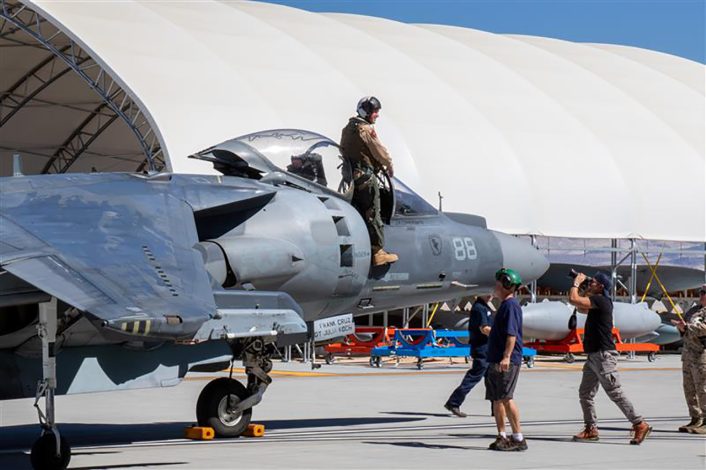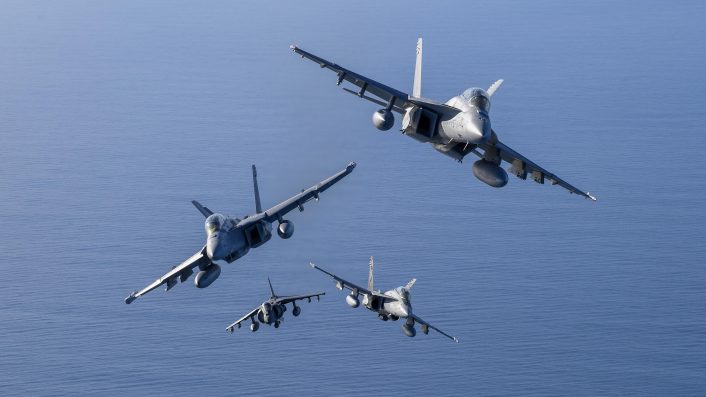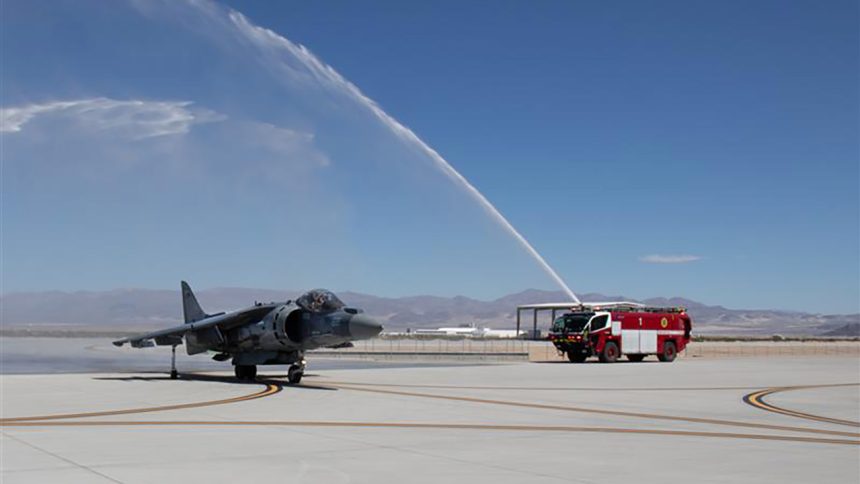The Dust Devils of VX-31 concluded the AV-8B Harrier’s service with a sundown flight at China Lake.
The Dust Devils of the U.S. Navy’s Air Test and Evaluation Squadron (VX) 31 concluded the AV-8B Harrier’s service with a sundown flight at Naval Air Weapons Station China Lake, California, on Sept. 23, 2025. The final flight, now confirmed by the service, was welcomed back on the ground by the traditional water salute,
The end of VX-31’s work on the AV-8B Harrier II follows the gradual transition of the U.S. Marine Corps from the legacy platform to the new F-35B Lightning II. The 5th generation jet will take the helm for the services STOVL (Short Take Off Vertical Landing) capabilities, bringing along new mission sets and new capabilities.
Sundown Ceremony
The final flight was followed by a sundown ceremony in VX-31’s hangar. Veterans, Sailors, Marines, government civilians, industry partners and family members gathered there for the occasion to say goodbye to a platform that served the fleet for more than four decades.

U.S. Marine Corps Lt. Col. Timothy “Little Buddy” Burchett, VX-31 commanding officer, described the Harrier as one of the most challenging and rewarding aircraft to fly. “It’s the most fun airplane I’ve ever flown,” said Burchett. “There are no computers. It’s cables, pulleys and skill that keep that thing in the air.”
Burchett praised the China Lake test team for keeping the program safe and mission capable to the finish. “We did not coast into the finish line. It was a triumphant finish for the team partnership,” he said.
“That jet right there flew its very first flight off the production line 33 years ago,” said Jim “Jimbo” Coppersmith, VX-31 technical director, who flew the aircraft for the final time.
“Today we completed AV-8B flight operations. We shut it down full mission capable, and it flew flawlessly. It’s a testament to what we’ve done to this aircraft as a team,” added Coppersmith, echoing Burchett’s words.
Further highlighting the importance of the Harrier II in the USMC, Coppersmith said “It’s the most successful attack aircraft in Marine Corps history. No doubt about it.”
Visualizza questo post su Instagram
Coppersmith also highlighted the squadron’s role in strengthening the aircraft’s combat effectiveness and safety record through decades of testing at China Lake. “We lost many great Marines along the way,” he said. “Those treatments and those material fixes, the procedures we wrote, the engineering changes we made, saved lives and limbs.”
Harrier’s Final Operations
As the Fleet Marine Force gradually dismisses the Harrier, the number of units to which it was assigned shrunk with only one unit remaining. In fact, Marine Attack Squadron (VMA) 223, also known as the “Bulldogs,” is the last Harrier squadron in the Marine Corps.
The unit, based at MCAS Cherry Point, North Carolina, is set to continue operating the platform through September 2026, according to the service. VMA-223 has also received the final two pilots graduated from the AV-8B Harrier II Fleet Replacement Detachment (FRD) in early 2024.
“The significance of the last replacement pilot training flight in the Harrier community is that it is the beginning of the end for us as a community.” said Capt. Joshua Corbett, one of the two pilots, after the graduation flight. The flight was a low-altitude close air support training sortie that allowed the pilots to receive the 7509 Military Occupational Specialty (MOS), which is reserved for AV-8B Harrier II qualified pilots.

“The Harrier, more than many aircraft than I have come across, elicits an emotional response,” added Corbett. “For members of the public, members of the aviation community, members of the Marine community, and especially members of the Harrier pilot community, it’s bittersweet. All good things have to come to an end, and it’s our turn soon, but not yet.”
Until then final retirement, the Harrier will continue to call MCAS Cherry Point home and execute deployed operations as part of Marine Expeditionary Units, says the USMC. This way, Cherry Point will be the first location that received the AV-8B – with the first production aircraft arriving there in January 1984 – and the last to dismiss it.









